There are plenty of skills required to be a successful customer service professional, such as patience and product knowledge. But empathy in customer service is the most important one.

A customer service rep’s goal is to help customers solve problems with their business and achieve success. With this in mind, reps should strive to empathize with and relate to customers because each has a unique problem that needs to be solved. That’s where empathy in customer service comes into the equation.
Want to help show customers that you’re on their side — and not trying to rush them off the phone? Keep reading to learn more about what empathy means to your business, why it’s important, and phrases you can use to demonstrate it. We’ll also share empathy in customer service examples.
What is empathy in customer service?
Empathy in customer service is the practice of listening to and understanding customer needs beyond a surface level. It requires a level of emotional intelligence to pick up on what customers’ subliminal messages and demonstrate that you care.
Why is empathy in customer service important?
Empathy in customer service is more than just important — it’s crucial. As a customer service representative, demonstrating empathy fosters healthy customer relations, can build customer loyalty over time, and even yield higher customer satisfaction. Remember: Customers don’t want to feel like they’re being ignored or brushed off; they want to know they’re supporting a business that has their back.
According to Zendesk, 62% of consumers believe businesses could offer more personalization and better customer experience. Furthermore, 95% of customers say that customer service impacts their brand loyalty.
The companies that recognize these staggering numbers see the value in offering customers exceptional experiences. By having empathy in customer service, it reveals that your company understands that human, authentic connection plays a vital role in customer decision-making.
A tool to help customer service reps deliver exemplary service is HubSpot’s Service Hub. The customer service software enables companies to prioritize the customer experience with an easy and connected platform that provides authentic service. By investing in customer service software, your company is demonstrating that deepening customer relationships is important to you.
 Get Free Customer Service Tools
Get Free Customer Service Tools
Now that you’re in the know about how empathy in customer service is crucial, let’s dive into some of the most helpful phrases customer service reps can use to build a connection.
Empathy Phrases For Customer Service Reps
1. "I hear you."
Pausing the conversation to let a frustrated customer know that you hear them and that you understand their feelings can build rapport and show empathy.
Pair this phrase with, “How can I help?” for maximum effectiveness. By asking how you can help, you can get a clear picture of the user’s specific pain points and can start to strategize. This allows you to move the conversation forward as you start to build a solution to these problems.
2. "Thanks for that suggestion. I certainly see how this could be useful."
Sometimes, your product or service falls short of what a specific customer is hoping to accomplish. In these scenarios, it’s important to acknowledge that their feedback is heard and valued, then point them in the right direction for a workaround. If an alternative solution isn’t possible, try to provide a community forum or feedback form where they can submit their idea.
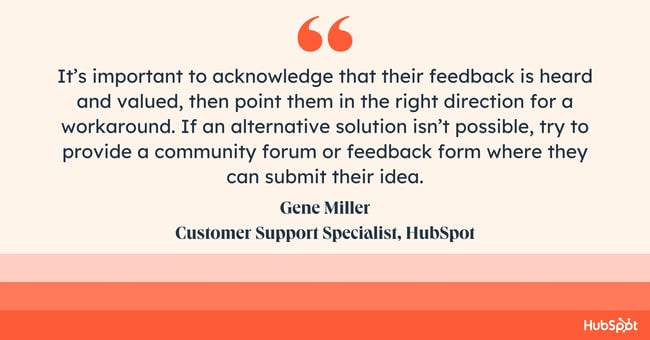 3. "I'm sorry to hear that."
3. "I'm sorry to hear that."
You don’t need to be in the wrong to say you’re sorry. “I’m sorry to hear that” makes it clear that you empathize with the customer’s pain and offers them the chance to vent if they feel the need.
4. "Wow — you've overcome a ton of adversity."
One of the best things you can do as a customer service representative is to acknowledge the struggles your customer has experienced. By using this phrase, you’re effectively doing so.
5. "I appreciate that feedback."
While customer service reps need to be mindful of what they say, customers don’t. Customers can speak freely about your products, services, and brand as a whole. And, sometimes, it isn’t pretty.
Rather than contesting the customer, sometimes it’s better to let them vent and thank them for their feedback. Remember, most of the time, the customer isn’t angry with the rep; they’re frustrated with the situation (or lack thereof). Thanking them for supplying feedback redirects the frustration back towards the problem, instead of the rep.
6. "I understand how 'x' is preventing you from accomplishing 'y.'"
When a customer is frustrated with a problem, it’s natural for support reps to say, “I understand.” However, this doesn’t acknowledge that you understand the problem. Rather, it shows that you’re focusing on the customer’s emotional response.
Instead of saying, “I understand your issue, and I am going to go investigate that,” be more specific and highlight why the customer’s problem is preventing them from achieving their goals.
Say something like, “I understand this issue is impacting your campaign’s timing. I want to make sure I give you the best answer, so I am going to conduct some tests and get back to you as soon as I have more information.”
By offering a timeline and calling out their specific scenario, you show the customer that you’re listening and have a game plan to solve for them.
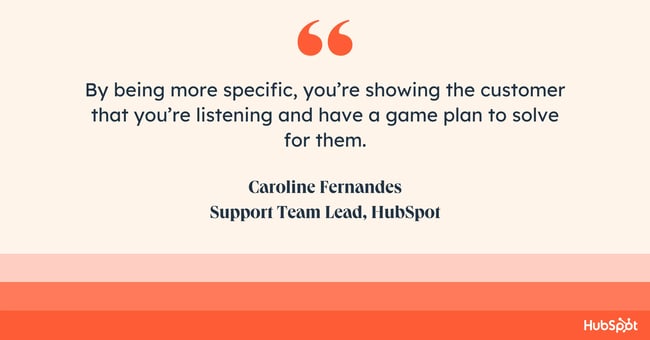 7. "I completely agree with you."
7. "I completely agree with you."
Sometimes, when customers are upset, the best thing a rep can do is validate their feelings. After all, it feels good when someone tells us we’re right, especially when we’re frustrated or angry.
Telling a customer that you agree with them doesn’t place your business in a negative light. In reality, it positions your brand as a company that listens to customer feedback and is actively looking for ways to improve your product or service. It also humanizes the entire experience for the customer, and reminds them that there’s a person there to help on the other side of the phone.
If your product has a flaw or is falling short of expectations, your team should seek a solution rather than ignoring it or hoping that it goes away.
8. "We can work through this together."
Using collaborative words like “we” takes the problem off of the customer’s shoulders and builds confidence that you’re working towards a resolution. It also empowers the customer to contribute to the troubleshooting effort and add color and context to the situation.
9. "That sounds extremely challenging."
The first step to overcoming a difficult task is to acknowledge that it’s challenging. Once we wrap our heads around the fact that we need help, we’re more likely to find a solution. By letting your customers know that what they’re going through is challenging, you can enable them to realize that they may need assistance.
10. "I hear you, and I want you to be successful."
Sometimes, when a case doesn’t go as planned, it can feel like it’s the rep versus the customer. In reality, the customer is frustrated with the problem, but it’s the rep who needs to de-escalate the tension. Telling the customer you want them to be successful reminds them that it’s you and the customer versus the problem. Remind them you’re on the same team.
It’s important to keep in mind your tone and sincerity. You need to be genuine and avoid “false empathy” if you want to resolve a friction-filled case.
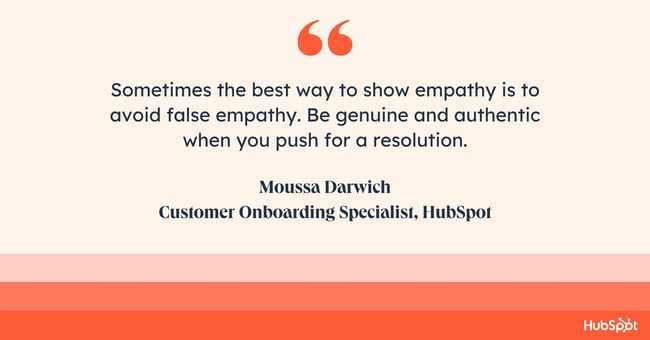
11. Say nothing — just listen.
Sometimes, the most impactful form of communication is silence. Brene Brown emphasizes in her book Daring Greatly that listening with empathy is the most effective way to process someone else’s perspective:
“Empathy is a strange and powerful thing. There is no script. There is no right way or wrong way to do it. It’s simply listening, holding space, withholding judgment, emotionally connecting, and communicating that incredibly healing message of ‘You’re not alone.’”
Besides providing the customer a shoulder to lean on, listening also helps customer service reps gain a better understanding of how to serve and help that customer. When you give the customer time to share their feelings, you also may gain additional context that can later help you offer a solution.
12. "Let’s turn this around for you."
When a negative experience disheartens a customer, reassurance that you are on their side and determined to fix the situation can provide comfort and instill trust in your commitment to their satisfaction.
13. "I can see why you’d want that feature."
When customers suggest new features or improvements, this phrase validates their needs and indicates that you value their input. It can make them feel more invested in your product or service.
14. "I would feel the same if I were in your shoes."
This statement shows your ability to put yourself in the customer’s position, enhancing your connection with them. It can make the customer feel less alone in their frustration. Again: Empathy in customer service is all about making the customer feel like they’re not the only one trying to solve the problem.
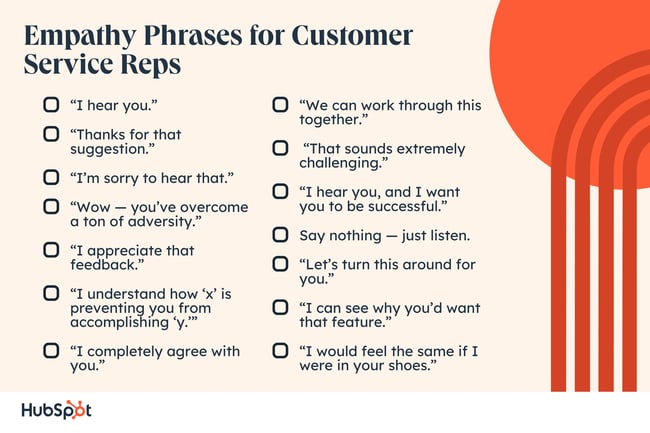
15. "Thank you for your patience."
This phrase is so simple, yet effective. Use it in cases where resolving an issue takes time. Thanking the customer for their patience is a way of acknowledging and alleviating their frustration. Also, it reassures them that you are working on the issue.
16. "I'll do my best to resolve this issue for you."
By pledging your commitment to resolution, you're confirming your dedication to the customer's satisfaction. It shows that you're invested in their happiness and committed to making things right.
17. "I appreciate your understanding."
Thanking the customer for their understanding emphasizes your appreciation for their patience and comprehension. It helps build rapport and defuses tension.
18. "I can see how that would be confusing."
Acknowledging the customer's confusion not only validates their feelings but also positions you as an ally who understands their viewpoint and is there to clarify and assist.
19. "What would your best-case scenario look like?"
This question helps identify the customer's ideal outcome, providing valuable insight into how best to meet their needs. It can be used when troubleshooting complex issues or when a customer is unsure of the solution they want.
"When appropriate, do not shy away from challenging your customers. The best customer success managers (CSMs) first recognize a customer's challenge or frustration, then give a variety of options for them to choose from. Giving just the answer to a customer's inquiry limits the potential value of them coming to you for guidance. Every interaction is a chance to help that customer grow and realize the true value of both the product and their CSM," says Aaron Schneider, a Customer Success Manager at HubSpot.
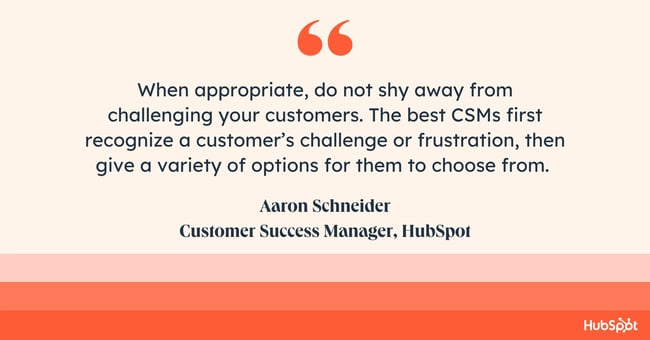
20. "How can we make it up to you?"
This phrase is similar to the above, but with a slightly different connotation. By asking this, you put the customer in a position of power, allowing them to suggest what would rectify the situation for them. It's particularly effective when conventional solutions aren't enough or when the issue has caused substantial trouble for the customer.
21. "Thanks for reaching out about this!"
It's a good opening phrase that sets a positive tone for the conversation, especially when the customer has a concern or complaint.
22. "I'll touch base with you/update you on X."
This statement assures the customer that you will keep them updated on the progress of resolving their issue. Use it when a solution may take some time to investigate and find the optimal resolution.
23. "I'll ensure you're updated every step of the way."
This is another way to reassure the customer that they won't be left in the dark about the progress. The phrase also reinforces your commitment to transparency.
Use this when dealing with issues that require longer resolution times.
24. "You've been extremely helpful. Thank you a million!"
Give credit to customers who have provided substantial information or worked with you through a complex problem-solving process. It shows your appreciation and acknowledges their efforts. Also, veering from business language shows you're a human. Authentic responses, sometimes even with emojis or memes if you're interacting digitally or in everyday language, help you build a connection and boost brand loyalty.
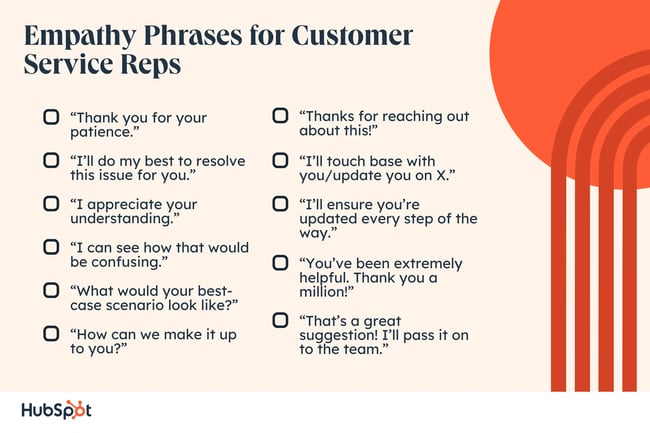
25. "That's a great suggestion! I'll pass it on to the team."
This phrase is appropriate when customers give valuable feedback or propose an idea for improvement. It makes them feel valued and encourages them to continue sharing their insights.
26. "I'm glad you reached out to us about this."
Use this to express relief that the customer chose to communicate their issue instead of just walking away. It shows the customer that their concerns are important to you and that you're ready to address them.
27. "Let's explore all your options."
This phrase is helpful when a customer is facing a difficult decision or when the first proposed solution doesn't fully meet their needs. It also shows that you're not satisfied finding an 'okay' resolution — you want one that makes the customer fully content.
28. "That's a valid concern."
This phrase can be used when a customer has worries or apprehensions about a product, service, or policy. It acknowledges their fear and opens the door for you to address and reassure them.
29. "Let's explore this together."
This suggests collaboration and a willingness to delve into the problem hand-in-hand with the customer. Resort to it when troubleshooting issues that require a team effort to solve or just a nice touch to simple issues.
30. "I'm truly sorry for the inconvenience caused."
If your product caused big trouble for your customer, this phrase conveys a deeper sense of regret. It's also suitable for situations where a mistake or oversight has resulted in significant inconvenience for the customer.

Examples of Empathy in Customer Service
Using the above phrases when speaking to customers in tough situations is how you make a positive impact they’ll remember and appreciate. Let’s discuss different scenarios where empathic service is beneficial. These examples of empathy in customer service give you a base understanding of when you can implement phrases of reassurance.
1. Meeting the needs of a customer in a crisis.
Global crises affect people on a huge scale.
For example, at the height of the COVID-19 pandemic in 2020, people’s daily lives were unbalanced or shaken up with the uncertainty of public health. The happening heightened people’s feelings of stress and anxiety, and in turn high-quality customer care became a more important factor to customers by almost 60%.
When stressful events like public health crises, natural disasters, political conflict, or other worldwide events are at the forefront of news, take that into consideration when communicating with customers. You never know how these events could be affecting them.
2. Understanding a customer’s frustration regarding a situation of high importance.
Oftentimes customers can find themselves distraught and rushing for a solution from service reps when something goes wrong at the wrong time. An example of this situation is a B2B customer distraught over strict deadlines for business work, where multiple people depend on them to deliver something that’s gone wrong.
Business can get tough, but your customer service team can use empathic listening and phrasing to let them know how important their need is, and that it will be resolved to the best of their ability.
3. Offering an exception to a valuable or loyal customer.
Your customers are human beings that have to worry about more than just paying for your product or service. That usually isn’t an area of contention, until problems arise.
For example, if one of your loyal customers has an accident or illness that demands their full attention or costly financial obligation, customer service reps should work with their team to see if they can temporarily relieve that customer of additional stress.
Exceptions like delaying payment or offering discounts for isolated instances is a level of empathic service that your customer will remember for time to come, so when they’re back on their feet, they’ll feel grateful for what your team has done.
Make Your Customer Service More Empathic
The core of every customer service rep’s job is to be helpful, and the best reps strive to help people solve pain points and turn weaknesses into strengths. By using these phrases on calls with customers, customer service reps can better solve problems and build rapport to help those customers get better outcomes from their product or service again and again.
Editor's note: This article was originally published in April 2020 and has been updated for comprehensiveness.











